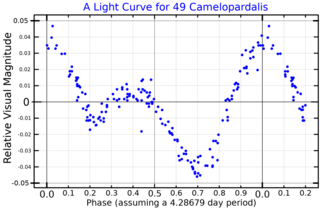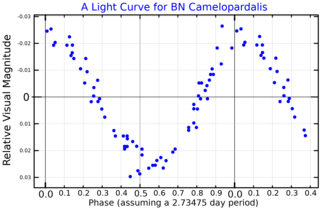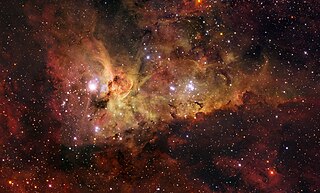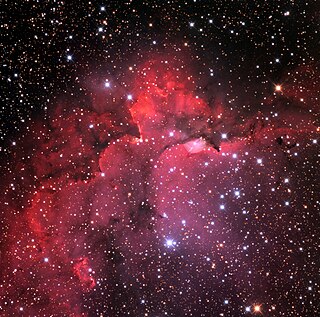Related Research Articles

A stellar association is a very loose star cluster, looser than both open clusters and globular clusters. Stellar associations will normally contain from 10 to 100 or more visible stars. An association is primarily identified by commonalities in its member stars' movement vectors, ages, and chemical compositions. These shared features indicate that the members share a common origin. Nevertheless, they have become gravitationally unbound, unlike star clusters, and the member stars will drift apart over millions of years, becoming a moving group as they scatter throughout their neighborhood within the galaxy.

CS Camelopardalis is a binary star in reflection nebula VdB 14, in the constellation Camelopardalis.
42 Camelopardalis is a single star in the constellation Camelopardalis, located roughly 770 light years away from the Sun. It is visible to the naked eye as a faint, blue-white hued star with an apparent visual magnitude of 5.14. The visual magnitude of the star is diminished by an extinction of 0.22 due to interstellar dust. It is moving further from the Earth with a heliocentric radial velocity of 3 km/s. 42 Camelopardalis has a peculiar velocity of 24.4+1.9
−2.1 km/s and may be a runaway star.

49 Camelopardalis is a variable star in the northern circumpolar constellation of Camelopardalis, located 313 light years from the Sun based on parallax measurements. It has the variable star designation BC Camelopardalis; 49 Camelopardalis is the Flamsteed designation. This star is a challenge to view with the naked eye, having a baseline apparent visual magnitude of 6.50. It is moving away from the Earth with a heliocentric radial velocity of +6.5 km/s.
V354 Cephei is a red supergiant star located within the Milky Way. It is an irregular variable located over 13,000 light-years away from the Sun. It has an estimated radius of 1,139 solar radii. If it were placed in the center of the Solar System, it would extend to between the orbits of Mars and Jupiter.

HD 21389 is a supergiant variable star in reflection nebula VdB 15, in the constellation Camelopardalis. It has the variable star designation CE Camelopardalis, abbreviated CE Cam. This object is part of the Camelopardalis OB1 association. The near-identical member CS Camelopardalis lies half a degree to the north.

BN Camelopardalis is a suspected astrometric binary in the northern circumpolar constellation of Camelopardalis. It appears as a variable star that is visible to the naked eye as a dim, white-hued point of light with an apparent visual magnitude that fluctuates around 5.49. The system is located at a distance of around 310 light years from the Sun based on parallax, and is drifting further away with a radial velocity of +9 km/s.

Cygnus OB2 is an OB association that is home to some of the most massive and most luminous stars known, including suspected Luminous blue variable Cyg OB2 #12. It also includes one of the largest known stars, NML Cygni. The region is embedded within a wider one of star formation known as Cygnus X, which is one of the most luminous objects in the sky at radio wavelengths. The region is approximately 1,570 parsecs from Earth in the constellation of Cygnus.

1 Camelopardalis is a double star system in the constellation Camelopardalis. Its combined apparent magnitude is 5.56 and it is approximately 800 parsecs (2,600 ly) away.

Trumpler 16 is a massive open cluster that is home to some of the most luminous stars in the Milky Way galaxy. It is situated within the Carina Nebula complex in the Carina–Sagittarius Arm, located approximately 9,270 ly (2,842 pc) from Earth. The cluster has one star visible to the naked eye from the tropics southward, Eta Carinae.

Carina OB1 is a giant OB association in the Carina Nebula, which is home to some of the most massive and luminous stars in the Milky Way Galaxy. It includes the young star clusters Collinder 228, NGC 3293, NGC 3324, IC 2581, Trumpler 14, Trumpler 15 and Trumpler 16, the last being the home of Eta Carinae. It also includes another massive and luminous star, HD 93129A. It is approximately 2,680 parsecs (8,700 ly) from Earth.

BC Cygni is a red supergiant and pulsating variable star of spectral type M3.5Ia in the constellation Cygnus.

XX Persei is a semiregular variable red supergiant star in the constellation Perseus, between the Double Cluster and the border with Andromeda.

CK Carinae is a variable star in the constellation Carina, the keel of Argo Navis. It is a member of the star association Carina OB1-D, at a distance of around 2,300 parsecs or 7,500 light years.

U Lacertae is a spectroscopic binary star in the constellation Lacerta.

Cepheus OB1 is an OB association around the cluster NGC 7380. The region is approximately 3,400 parsecs from Earth in the constellation of Cepheus, although many of its stars lie in neighboring constellations like Cassiopeia.

HD 151932, also known as WR 78, is a Wolf-Rayet star located in the constellation Scorpius, close to the galactic plane. Its distance is around 1,300 parsecs away from the Earth. Despite being a blue-colored Wolf-Rayet star, it is extremely reddened by interstellar extinction, so its apparent magnitude is brighter for longer-wavelength passbands. HD 151932 lies about 22′ west of the open cluster NGC 6231, the center of the OB association Scorpius OB1; it is not clear whether it is a part of the association or not. With an apparent magnitude of about 6.5, it is one of the few Wolf-Rayet stars that can be seen with the naked eye.

HD 152408, also known as WR 79a, is a Wolf-Rayet star located in the constellation Scorpius, close to the galactic plane. Its distance is around 2,020 parsecs away from the Earth.

NGC 6383 is an open cluster of stars in the constellation of Scorpius. It was discovered by English astronomer John Herschel in 1847. In the New General Catalogue it was also identified as NGC 6374, most likely due to a clerical error. This is a large cluster of scattered stars that spans an angular diameter of 20′. The brightest component is the O-type binary star system designated HD 159176. Against the glare of this sixth magnitude star, a handful of fainter members are visible with a pair of large binoculars.
References
- 1 2 Ruprecht, J.; et al. (February 1982). "Catalogue of Star Clusters and Associations, Supplement 1, Associations". Bulletin d'Information du Centre de Donnees Stellaires. 22: 132. Bibcode:1982BICDS..22..132R.
- 1 2 3 4 5 Straižys, V.; Laugalys, V. (2007). "Young Stars in the Camelopardalis Dust and Molecular Clouds. I. The Cam OB1 Association". Baltic Astronomy. 16: 167–182. arXiv: 0803.2461 . Bibcode:2007BaltA..16..167S.
- ↑ Ward, Jacob L.; Kruijssen, J. M. Diederik (April 2018). "Not all stars form in clusters - measuring the kinematics of OB associations with Gaia". Monthly Notices of the Royal Astronomical Society. 475 (4): 5659–5676. arXiv: 1801.03938 . Bibcode:2018MNRAS.475.5659W. doi: 10.1093/mnras/sty117 .
- 1 2 Melnik, A. M.; Dambis, A. K. (April 2020). "Internal motions in OB associations with Gaia DR2". Monthly Notices of the Royal Astronomical Society. 493 (2): 2339–2351. arXiv: 2002.05044 . Bibcode:2020MNRAS.493.2339M. doi: 10.1093/mnras/staa454 .
- ↑ Alter, Georg; Israel, B. Y.; Ruprecht, J. (1966). Catalogue of star clusters and associations. Bibcode:1966csca.book.....A.
- 1 2 Lyder, David A. (November 2001). "The Stars in Camelopardalis OB1: Their Distance and Evolutionary History". The Astronomical Journal. 122 (5): 2634–2643. Bibcode:2001AJ....122.2634L. doi: 10.1086/323705 . S2CID 120758592.
- ↑ Lin, Chien-Cheng; et al. (October 2013). "Characterization of the Young Open Cluster G144.9+0.4 in the Camelopardalis OB1 Association". The Astrophysical Journal. 775 (2): 9. arXiv: 1308.6162 . Bibcode:2013ApJ...775..123L. doi:10.1088/0004-637X/775/2/123. S2CID 119232150. 123.